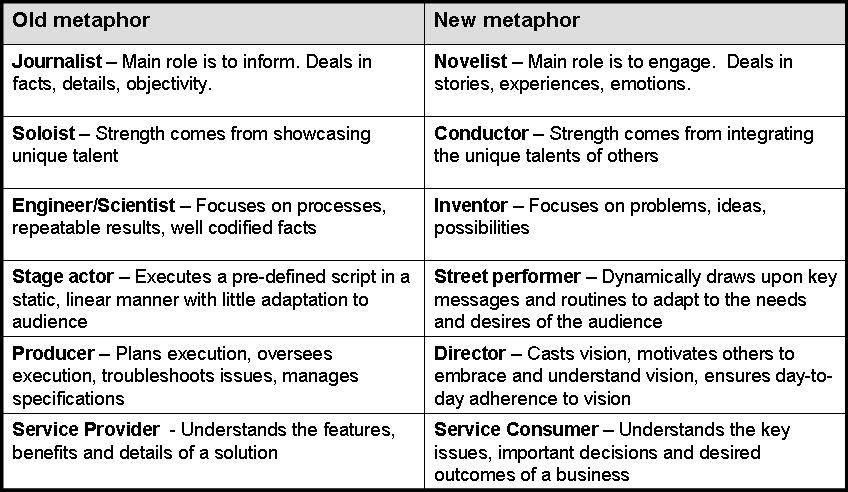 Daniel Pink’s book, A Whole New Mind, lists the new “senses” required to thrive in our new, “conceptual” age. The six new senses are design, story, symphony, empathy, play and meaning. Many of these are in direct contrast to what we’ve heard and seen as leaders for the past several decades. So, where can we look for role models?
Daniel Pink’s book, A Whole New Mind, lists the new “senses” required to thrive in our new, “conceptual” age. The six new senses are design, story, symphony, empathy, play and meaning. Many of these are in direct contrast to what we’ve heard and seen as leaders for the past several decades. So, where can we look for role models?
I’ve identified six new role models to serve as metaphors for making this shift. These roles are not meant to be one-to-one mappings against Pink’s senses. However, they follow the general spirit of his book. Learning how people in these roles think and operate can provide great insights into leading. Of course, this isn’t to say that the “old” metaphors should be tossed out. A good leader draws from both sets as needed.
Journalist to Novelist
Data and facts obviously are critical. Leaders cannot make up reality. Great leaders generate meaning, context, and excitement around those facts. People don’t commit their time, energy, and support to facts. They commit to a vision or a story. They want a picture that puts them or something they care about in a better place.
Soloist to Conductor
You simply can’t do it all on your own anymore. Business has become too complex. Even if you had the ability, you don’t have the time. Leadership is not about being the expert. Leadership is the ability to coordinate the expertise of others to achieve your goals. How can you think more like a conductor? Read The Art of Possibility by Rosamund and Benjamin Zander. Ben is the conductor of the Boston Philharmonic.
Engineer/Scientist to Inventor
A partner at a professional services company once gave me this advice with regard to creating value, “Focusing on cost containment creates value but has a limit. The best you can ever do is eliminate the cost. Growth on the other hand has no limit. The possibilities are endless.” Good execution is no longer enough to differentiate your company, especially when basic processes can be off-shored for 1/10 of their current cost. You grow not shrink your way to success. Start thinking like an inventor and harness opportunities and possibilites. Where can you start? Consider Michael Gelb’s book, “How to Think Like Leonardo DaVinci.”
Stage Actor to Street Performer
These titles are from a model in Joseph Pine and James Gilmore’s book, “The Experience Economy.” Gilmore and Pine argue that we’ve moved from a service to an experience economy. Value is created not just from a product or service, but from the context in which that product or service is provided. Experience equals memory. A doll is a product; a day at the American Girl Store is an experience. Memories are achieved by providing a unique experience for each person. This is what a street performer does. The street performer has a “bag of tricks” but puts them together in unique ways based on the audience and what is happening around him. The stage actor, on the other hand, executes the same script, start to finish, regardless of context or the audience’s reaction. Your employees, customers, and business associates are looking for a unique experience from you. Use your bag of tricks wisely and tailor it to the needs of your audience.
Producer to Director
I often view this as the distinction between management and leadership. Producers ensure that everything is getting done in the most efficient and effective way. Directors ensure that the overall outcome and vision is being met. They help people “get into their role” or “find their motivation”. They guard the integrity of the story. Every organization has a story that is unfolding.
Provider to Consumer
People don’t want your products or services; they want their needs to be met. I once heard of a training exercise conducted at Dell. Participants were paired off and one was told to make a fist. The other was instructed to get his or her partner’s fist open. Most people tried force, bargaining, or threatening. Michael Dell looked at his partner and said, “What can I do to get you to open your fist” He succeeded. Get used to looking at the world through the needs of your people or your customer. Don’t start your agenda (your marketing messages, features of your product or services, etc.). Start with your customer or audience’s need . To jump start the process, read Paco Underhill’s book, “Why we buy.”


